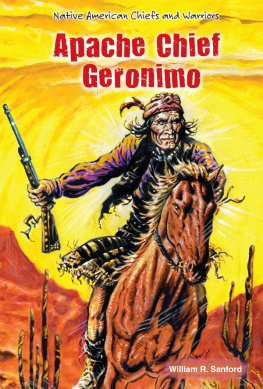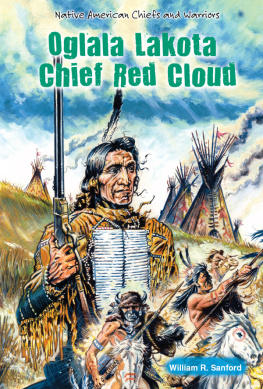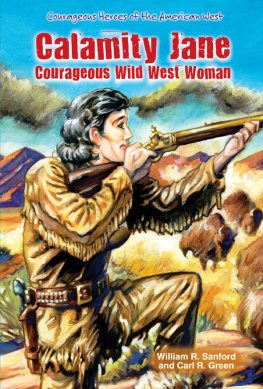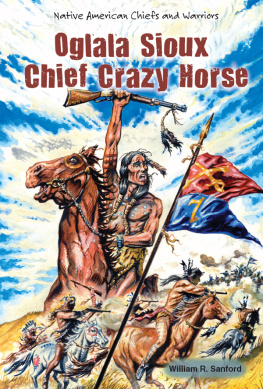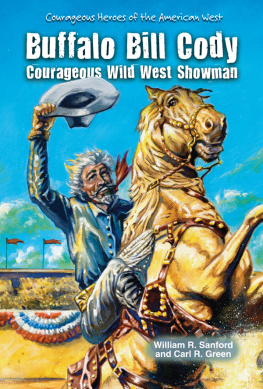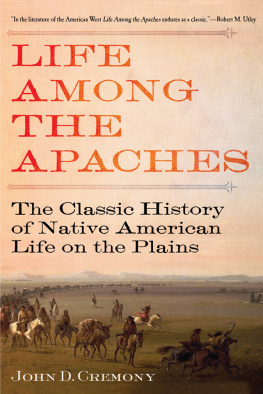
Apache Chief Geronimo
The name Geronimo struck fear into the hearts of settlers and soldiers throughout the Southwest and Mexico in the late 1800s. In thrilling fights, Apache Chief Geronimo would lead his band of warriors against American and Mexican soldiers.
Based on the words of Apache Chief Geronimo and on other writtenaccounts, the author tells the real story of this fearless warrior.
About the Author
William R. Sanford is the author of numerous books for young people. He brings many years of teaching experience to the books he has created.
This book tells the true story of the Apache warrior, Geronimo. Many mistakenly think the great warrior led all the Apaches. But his true fame rests on his leadership of only a relative few. After the deaths of the Apache chiefs Cochise and Mangas Coloradas, the press raced to print stories about Geronimo. Some were made up, but others were true. The events described in this book all really happened.
World War II brought a new kind of warfare. Soldiers dropped from planes by parachute onto enemy soil. As they jumped, they recalled the Apache raider who struck without warning. They shouted: Geronimo!

Image Credit: Library of Congress
The Apache war leader, Geronimo, brought fear to settlers throughout the Southwest. This fierce warrior is remembered for his raiding and breakouts from reservation life.
Geronimothe Apache warrior scowls at us from his photos. A barrel chest tops his five foot, eight inch frame. His nose is like the beak of a hawk. His eyes resemble black glass. Jutting cheekbones and a slit of a mouth add to his glare. What made him so fierce?
As a child, Geronimo learned of the hatred between Apaches and Mexicans. For centuries the Mexicans had captured his people and made them slaves. The Apaches struck back. They raided Mexican ranches and towns. They herded off horses and cattle. Raiding became a normal way of life. To the Apaches, these raids were lawful and just.
The Mexicans wanted to wipe out the Apaches. They offered money for every Apache scalp. In 1837, the Mexican state of Chihuahua offered 100 pesos (about $100) for each scalp of an Apache warrior. The state would pay fifty pesos for a womans scalp and twenty-five pesos for a childs. Other states made similar offers.
The United States and Mexico were at war from 1846 to 1848. At the end of the war, the peace treaty made the Southwest part of the United States. About this time, one Mexican stateChihuahuatried to end the Apache raids. It urged the Apaches to come and trade for what they wanted.
Geronimo went with his band to the Mexican frontier town of Janos. The Apaches camped in the dry hills outside of town. They planned to trade hides and furs for cloth, knives, and guns. They also hoped to sell the livestock they had stolen in Sonora. Most of the men walked to town to trade. The Apaches did not trust their hosts. They left a small guard to protect the women and children.
The town had gifts for the Apaches. It gave them sacks of supplies. It also gave them bottles of liquor. These the Apaches opened at once. Soon many Apaches were drunk. They staggered back to camp. Geronimo brought gifts for his three children. He gave his supplies to his wife, Alope.
The next day, the town again gave gifts. Both sides were happy. The town thought it had bought peace cheaply. The Apaches got supplies without raiding. Geronimo and the others walked toward camp. Women and children ran to them screaming. Mexican soldiers had attacked their camp. They were still there.
Troops from Sonora had crossed the Chihuahua state line. Outside Janos, they came upon the Apache camp. They killed all the guards. They slaughtered more than 100 women and children. Some Apaches scattered into the brush hiding there until dark. When the soldiers left, they took with them 100 captive Apache women and children. In the towns to the south, they would sell them as slaves.
Only eighty warriors remained. They had no arms or supplies with which to fight. They hid in a thicket until the troops had gone. Late that night, they entered the camp. Geronimo said, I found that my aged mother, my young wife, and my three small children were among the slain. There were no lights in camp. Without being noticed, I silently turned away. I stood by the river. How long I stood there, I do not know.
The Apaches left their dead on the field. The next day, they headed north. Geronimo would never forget what happened at Janos. For the rest of his life, he would seek revenge.
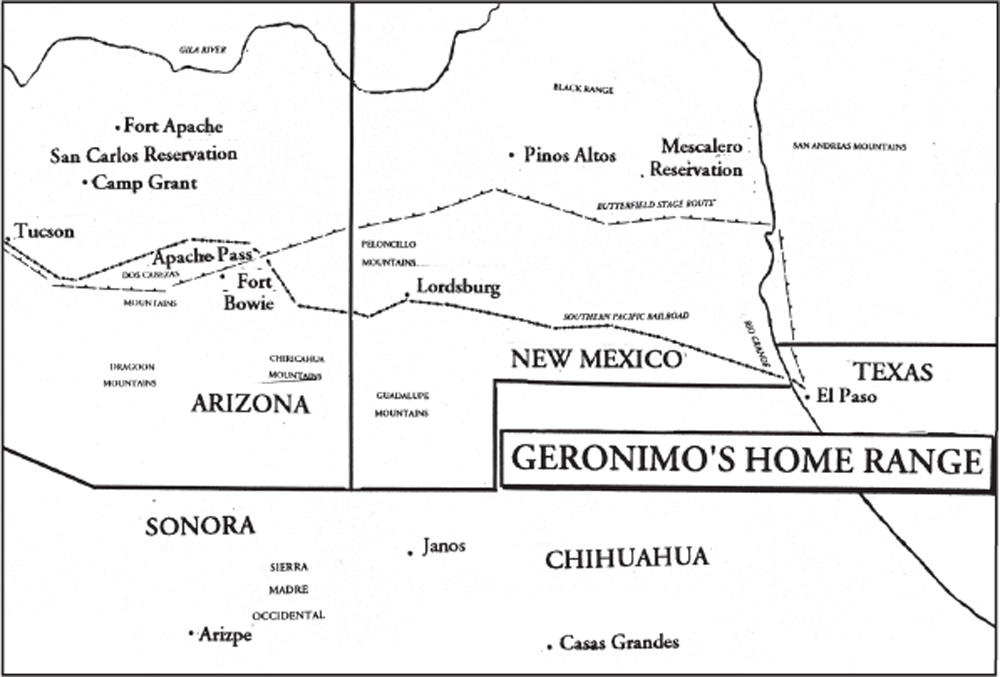
Image Credit: Library of Congress
The Apache homeland stretches from Arizona, New Mexico and Texas into northern Mexico.
The Apaches called themselves the Din and Ind, which mean the people. The name Apache comes from the Zun Apacheu. It means enemy. The Apaches believe that the sun created them. Historians say the Apaches came to the Southwest from western Canada. At their peak in the 1800s, there were about 12,000 Apaches. They divided themselves into six groups. The Apaches built no cities. They moved from place to place. Their land could not support year round farming.
Geronimo said that he was born in June 1829. He placed his birth in No-doyohn canyon in southeast Arizona. His name at birth was Go Khla Yeh (One Who Yawns). It was the Mexicans who called him Geronimo (Spanish for Jerome). No one knows why the Mexicans gave him this name. Geronimo was the grandson of Chief Mahko. His father was Taklishim (The Gray One) and his mother's was Juana. They belonged to a group of Apaches known as the Bedonkohe.
Geronimo lived in a land of searing deserts, blue mountains, and deep canyons. In this harsh land, only the strong and clever survived. He grew up with one sister, Nah-de-ste, and six cousins. The young boys and girls helped gather roots, wild fruit, and nuts. They worked with their parents in the fields. Each family had a small garden plot. Beans and pumpkins grew between rows of corn. In the fall, they carried the harvest to the mountains. There they sealed the food in caves until needed.
At age five or six, Geronimo began training to be a warrior. He made weapons and tools. He took care of the horses. Geronimo learned to hunt small game with a bow and arrows. By the time he was fourteen, he hunted with the men. They taught him the skills of war. He learned to shoot, dodge, hide, and track. On the prairies, he hunted deer, elk, and antelope. Often he hunted cougar. Geronimo killed several of the big cats with a bow and arrows. One he killed with a spear. He used the animal hide to make quivers for arrows. Hunting parties traveled great distances to find buffalo. On horseback, the hunters rode into the herd. At close range, they let loose their spears and arrows. They brought back the hides to use as bedding and covers for tipis.

Image Credit: Library of Congress
Geronimo lived in a land of searing deserts, blue mountains, and deep canyons. This is Apache territory in what is now Arizona.
As a child, Geronimo never saw a white person. When in his teens, he joined Chief Juh in raids on ranches and pack trains. The raiders crossed open spaces only at night. During the day, they hid in the mountains.
Next page
